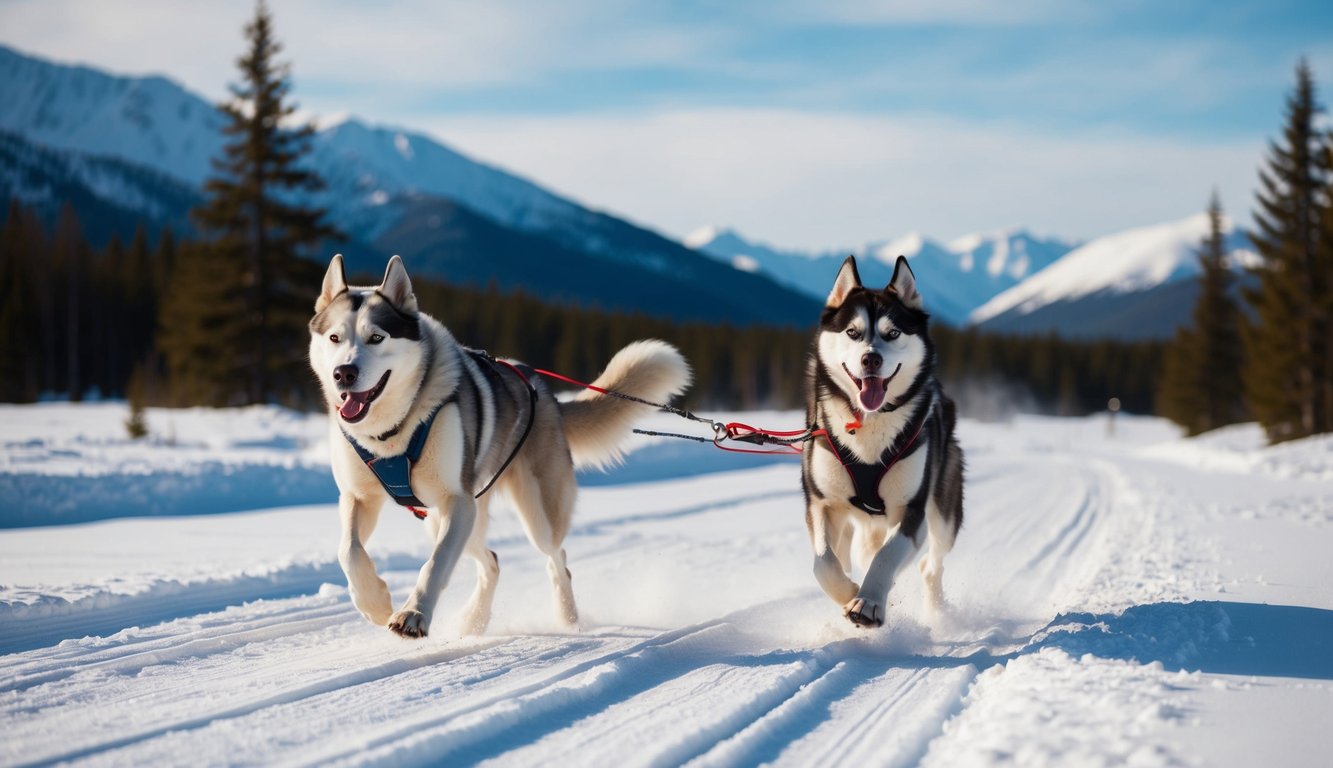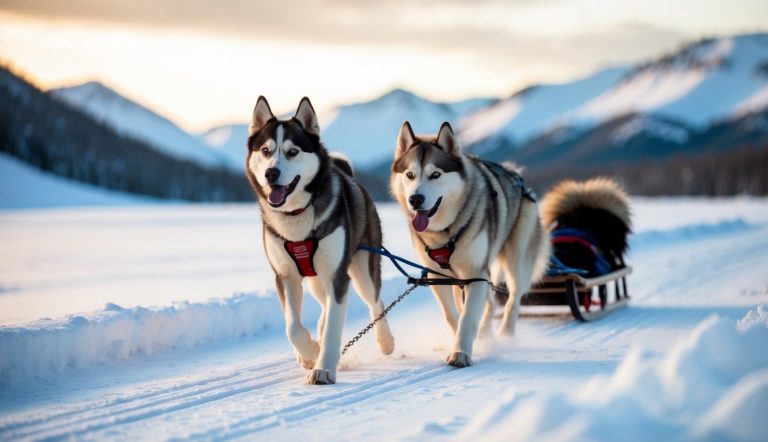The Siberian Husky and Alaskan Malamute have distinct origins rooted in different Arctic regions. These breeds were developed for specific purposes by indigenous peoples, shaping their unique traits and abilities. Let’s take a closer look at the similarities and differences between these two dog breeds.
If you’re still on the market to buy a Siberian Husky or Alaskan Malamute, PuppySpot currently offers a $300 discount using the code PUPPY300, just click the banner below!
Physical Characteristics
Siberian Huskies and Alaskan Malamutes have distinct physical features that set them apart. These breeds share some similarities but differ in size, build, and coat patterns.
Size and Stature
Alaskan Malamutes are larger and more powerful than Siberian Huskies. Malamutes stand 22 to 26 inches tall and weigh 75 to 100 pounds. Huskies are smaller, measuring 20 to 23½ inches in height and weighing 35 to 60 pounds.
Malamutes have a sturdy, muscular build suited for hauling heavy loads. Their broad chests and strong legs give them a robust appearance. Huskies have a leaner, more agile frame built for speed and endurance.
Both breeds have erect, triangular ears. Malamute ears are set wider apart on the head compared to Huskies.
Coat and Color Patterns
- Both breeds have thick double coats to protect them from harsh Arctic conditions. The undercoat is dense and woolly, while the outer coat is longer and coarser.
- Siberian Huskies come in a wider variety of colors and patterns. Common colors include black, gray, red, and white. They often have striking facial markings and blue or multi-colored eyes.
- Alaskan Malamutes typically have gray, black, or sable coats with white markings. Their coloration is usually more uniform than Huskies. Malamutes have brown, almond-shaped eyes.
- Both breeds shed heavily, especially during seasonal changes. Regular brushing helps manage their coats and reduce shedding.

Temperament and Personality
Siberian Huskies and Alaskan Malamutes have distinct personalities shaped by their history as working dogs. Both breeds display loyalty, affection, and a strong pack mentality, but they differ in key behavioral traits.
Behavioral Traits
- Siberian Huskies are known for their playful and mischievous nature. They often have a high energy level and enjoy activities that challenge them mentally and physically. These dogs can be stubborn at times, making training a bit challenging.
- Alaskan Malamutes tend to be more laid-back compared to Huskies. They are generally calm and dignified, but still enjoy playtime. Malamutes are strong-willed and may try to assert dominance if not properly trained.
- Both breeds have a strong prey drive due to their working dog heritage. This trait can make them chase small animals if not properly socialized.
Socialization Aspects
- Early socialization is crucial for both Huskies and Malamutes. They need exposure to different people, animals, and environments from a young age to develop into well-rounded adults.
- Siberian Huskies are typically friendly with strangers, making them poor guard dogs but excellent companions. They get along well with children and other dogs when properly socialized.
- Alaskan Malamutes can be more reserved with strangers. They bond closely with their family but may not seek attention from others as readily as Huskies do. Malamutes generally do well with children but may need supervision due to their large size.
- Both breeds have a strong pack mentality and thrive on being part of a family unit. They can develop separation anxiety if left alone for long periods.

Health and Lifespan
Siberian Huskies and Alaskan Malamutes share some health concerns but differ in others. Both breeds have similar lifespans, but their health needs vary.
Common Health Issues
- Siberian Huskies may face eye problems like cataracts. This can lead to vision loss if not treated early. They can also develop hip dysplasia, a joint condition that causes pain and mobility issues.
- Alaskan Malamutes are prone to hip dysplasia too. They may also suffer from hypothyroidism, which affects their metabolism. Both breeds can get bloat, a serious stomach condition.
- Huskies might have a genetic disorder called hereditary thrombopathy, similar to hemophilia in humans. This affects blood clotting and can be dangerous.
- Regular vet check-ups are key for both breeds. Proper diet and exercise help prevent many health issues.
Average Lifespan
Both Siberian Huskies and Alaskan Malamutes have similar life expectancies. They typically live between 12 to 15 years.
Good care can help these dogs reach the upper end of this range. This includes:
- Regular exercise
- Proper nutrition
- Dental care
- Routine vet visits
Genetics play a role in lifespan too. Buying from reputable breeders who do health screenings can help ensure healthier dogs. Some Huskies and Malamutes may live beyond 15 years with excellent care and good genes. However, this is not common and shouldn’t be expected.
Exercise and Energy Levels
Siberian Huskies and Alaskan Malamutes are known for their high energy and exercise needs. These sled dogs require lots of physical activity to stay healthy and happy.
Sled Dogs’ Energy Expenditure
- Siberian Huskies and Alaskan Malamutes have incredible endurance. They can run for hours, pulling sleds across snowy landscapes. This stamina comes from their history as working dogs in harsh Arctic climates.
- Huskies are slightly more energetic. They love running and have boundless stamina. Malamutes are also high-energy, but may tire a bit sooner than Huskies.
- Both breeds need lots of exercise to burn off energy. Without enough activity, they can become bored and destructive.
Exercise Needs for Family Pets
As pets, Huskies and Malamutes still need lots of exercise. They do best with active owners who can keep up with their energy.
Daily activities for these breeds should include:
- Long walks or jogs
- Playtime in a fenced yard
- Dog sports like agility or bikejoring
Malamutes may need more exercise due to their larger size. Huskies can often be satisfied with shorter but more intense exercise sessions. Both breeds enjoy playing and interacting with their families. Mental stimulation through games and training is also important to keep these smart dogs happy.

Training and Obedience
Siberian Huskies and Alaskan Malamutes have distinct training needs due to their strong-willed natures. Both breeds require consistent, patient approaches to develop good behaviors and obedience.
Training Methods
- Positive reinforcement works best for both Huskies and Malamutes. Treats, praise, and play can motivate these intelligent dogs. Short, frequent training sessions keep their interest.
- Malamutes may be more difficult to train than Huskies due to their headstrong personalities. Early socialization is key for both breeds to prevent behavior issues.
- Obedience classes can help first-time owners establish good habits. Basic commands like sit, stay, and come should be prioritized. Leash training is crucial, as both breeds have strong prey drives.
Challenges in Training
- Huskies and Malamutes can be stubborn, making training a test of patience. Their independent nature means they may not always listen to commands.
- Huskies have high energy levels that can lead to destructive behaviors if not properly exercised and mentally stimulated. Malamutes are strong and may try to assert dominance without firm leadership.
- Neither breed typically excels as guard dogs or watchdogs due to their friendly temperaments. However, proper training can improve their alertness and protective instincts.
- Consistency is key. Letting these breeds get away with disobedience even once can set back training progress significantly.
Grooming and Maintenance
Siberian Huskies and Alaskan Malamutes have thick double coats that need regular care. These breeds shed a lot and require consistent grooming to keep their coats healthy.
Coat Care
- Both Huskies and Malamutes have a dense undercoat and longer guard hairs. This coat keeps them warm in harsh climates. They need brushing with a slicker brush and metal comb to remove loose fur and prevent mats.
- Bathing should be done only when needed, as it can strip natural oils from their coat. Use dog-specific shampoos to maintain coat health.
- During shedding seasons, daily brushing is vital to manage the heavy fur loss. A deshedding tool can help remove loose undercoat.
Grooming Frequency
- Regular grooming is key for both breeds. They need brushing at least 2-3 times a week, more during shedding seasons. This helps distribute skin oils and keeps their coat looking good.
- Nail trimming should be done monthly. Check and clean ears weekly to prevent infections. Brush their teeth several times a week for good dental health.
- Professional grooming every few months can help with thorough coat care and maintenance. This is especially useful during heavy shedding periods.



